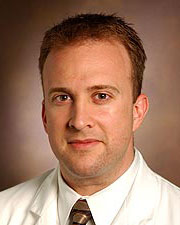Whole blood for trauma resuscitation research published in JACS

Recent research led by Bryan Cotton, MD, professor in the Department of Surgery, on the impact of the use of whole blood for trauma resuscitation was featured in the Journal of the American College of Surgeons.
The abstract titled “Impact of Incorporating Whole Blood into Hemorrhagic Shock Resuscitation: Analysis of 1,377 Consecutive Trauma Patients Receiving Emergency-Release Uncrossmatched Blood Products,” resulted from a prospective observational cohort study of injured patients receiving emergency-release blood products.
Each patient was resuscitated between November 2017 and September 2020 and included patients receiving any group 0 whole blood units. A component group received fractionated blood (red blood cells, plasma, and platelets) in lieu of whole blood units.
In total, 840 patients received whole blood, while 537 were in the component group. Whole blood patients had a higher anatomic injury (Injury Severity Score 27 vs. 20), and greater evidence of shock, with lower field blood pressure (103 vs. 114) and higher arrival lactate (4.2 vs. 3.5; all p<0.05).
While initial analysis showed similar survival between the whole blood and component groups (75 vs. 76%), logistic regression found that whole blood was independently associated with a 4-fold increased survival (odds ratio 4.10, p<0.001) and had a 60% reduction in overall transfusion with the impact on survival remaining consistent regardless of location of transfusion, severity of overall anatomic injury, or presence of head trauma.
“Bleeding is the number one cause of preventable death in trauma, and death from hemorrhage occurs in the first 90 minutes after injury,” Cotton said. “Our data shows that early transfusion of whole blood can save lives and reduce our use of the precious resource of donated blood.”
Contributing authors for the paper in the Department of Surgery include Krislynn Mueck, MD, fellow; Gabrielle Hatton, MD, resident; and Lillian Kao, MD, professor. Other contributing authors are Jason Brill, MD; Brian Tang, BS; and Cameron McCoy, MD.